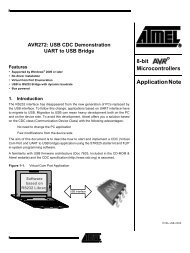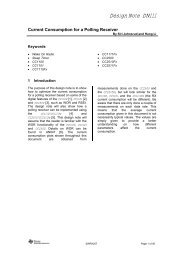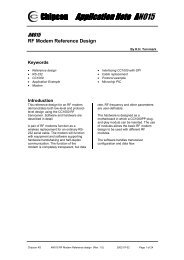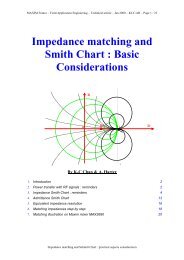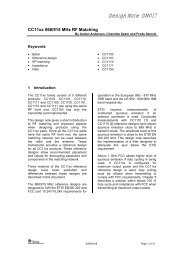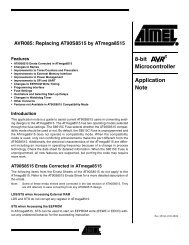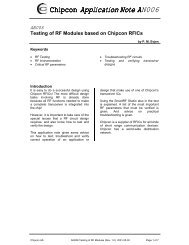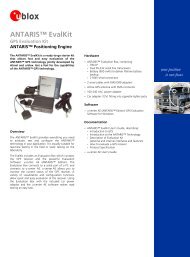AN068 - Design Steps and Results for Changing PCB Layer Thickness
AN068 - Design Steps and Results for Changing PCB Layer Thickness
AN068 - Design Steps and Results for Changing PCB Layer Thickness
Create successful ePaper yourself
Turn your PDF publications into a flip-book with our unique Google optimized e-Paper software.
Application Note <strong>AN068</strong><br />
<strong>AN068</strong><br />
<strong>Design</strong> <strong>Steps</strong> <strong>and</strong> <strong>Results</strong> <strong>for</strong> <strong>Changing</strong> <strong>PCB</strong> layer<br />
thickness <strong>for</strong> Low Power Wireless Reference EVMs<br />
By Rea Schmid<br />
Keywords<br />
• Board Stacking <strong>for</strong> RF <strong>Design</strong><br />
• VSWR changes with Stacking<br />
• B<strong>and</strong>width <strong>and</strong> <strong>Layer</strong> Stacking<br />
• <strong>PCB</strong> <strong>for</strong> CC25xx Devices<br />
• 062 Mil <strong>Layer</strong> Stacking<br />
• FR4 Dielectric Material<br />
• EVM <strong>for</strong> Low Power Wireless<br />
• Board per<strong>for</strong>mance <strong>for</strong> RF <strong>Design</strong><br />
• Matching networks <strong>for</strong> <strong>PCB</strong> Boards<br />
• Discrete Component Balun <strong>Design</strong><br />
• Matching antenna<br />
• RF Filter <strong>Design</strong><br />
Introduction<br />
Texas Instruments provides Evaluation<br />
Modules (EVMs) <strong>for</strong> easy characterization<br />
of the Low Power Wireless (LPW)<br />
products. They provide a means to<br />
underst<strong>and</strong> the device’s operation, <strong>and</strong><br />
decrease the product development time.<br />
Often a customer will copy the hardware<br />
layout, <strong>and</strong> then make small changes that<br />
can cause the per<strong>for</strong>mance to change.<br />
The most common changes are modifying<br />
the layer board stacking or changing<br />
component placement. Each of these will<br />
mistune the matching or filter networks<br />
<strong>and</strong> even the antenna, reducing the<br />
system per<strong>for</strong>mance.<br />
Learning how the <strong>PCB</strong> layer stack causes<br />
a mismatch at the RF connection between<br />
the RF output pins to the antenna is the<br />
scope of this application note.<br />
TI’s Evaluation Boards are designed to be<br />
flexible <strong>and</strong> easy to use. The boards are<br />
designed to accommodate a range of<br />
VSWR to make them acceptable <strong>for</strong> wide<br />
range of use. All EVMs are designed <strong>for</strong> a<br />
maximum VSWR of 2, which translates to<br />
a minimum return loss (RL) of -9.5dB<br />
derived from the S11 s-parameter.<br />
Each TI device specifies a typical load<br />
found in the data sheet that is used to<br />
match <strong>and</strong> complete the maximum power<br />
transfer. The spec is <strong>for</strong> a given<br />
frequency of operation. The number is<br />
used as the starting point <strong>for</strong> designing the<br />
interface to a selected antenna. For many<br />
applications the load is single ended; since<br />
most chips provide a differential<br />
input/output, the circuit often must include<br />
a translation to interface to a single-ended<br />
antenna. Typically these interfaces include<br />
three circuit blocks consisting of a balun, a<br />
filter/matching network, <strong>and</strong> finally a<br />
connection to the antenna, either through<br />
an SMA connector or directly connected.<br />
A note about the use of discrete<br />
components: values at 2.45GHz are often<br />
small with units on the order of pico-farads<br />
<strong>and</strong> nano-henries. There<strong>for</strong>e, the final<br />
solution per<strong>for</strong>mance is often sensitive to<br />
layout traces <strong>and</strong> pads.<br />
There are several methods used to design<br />
<strong>and</strong> select the circuit components <strong>and</strong><br />
trace lengths. The methods often used<br />
are Smith Charts, Simulation programs,<br />
Circuit Analysis, or copying <strong>and</strong> scaling<br />
existing designs. But at the higher<br />
frequencies one must recognize the use of<br />
tools greatly increases the accuracy of the<br />
final design.<br />
1<br />
SWRA236<br />
Page of 20
Application Note <strong>AN068</strong><br />
Because of the high frequencies <strong>and</strong> the<br />
fact we are using FR4 material, there are<br />
many additional factors to consider; FR4<br />
permittivity, stacking height, magnetic<br />
fields, trace thickness <strong>and</strong> solder mask.<br />
Not to mention it is difficult to make<br />
measurements at these frequencies<br />
without equipment like VNAs or TDRs.<br />
For this discussion we tried to isolate the<br />
effects of changing the stacking height to<br />
better underst<strong>and</strong> its impact upon the<br />
overall board’s per<strong>for</strong>mance as one makes<br />
this change. These results are included at<br />
the end of the application note.<br />
Keywords........................................................................................................................................................ 1<br />
Introduction .................................................................................................................................................... 1<br />
Abbrevations: ............................................................................................................................................. 3<br />
LPW Evaluation Boards ................................................................................................................................. 4<br />
Why RF designs change with Board <strong>Layer</strong> Stacking.................................................................................. 4<br />
Circuit Schematic of balun/matching Network. .......................................................................................... 6<br />
<strong>PCB</strong> Layout Techniques <strong>for</strong> Board Stacking Change..................................................................................... 6<br />
2-<strong>Layer</strong> <strong>Design</strong>s.......................................................................................................................................... 6<br />
<strong>PCB</strong> Traces <strong>and</strong> Transmission Lines .......................................................................................................... 7<br />
Determine the Source Impedance ............................................................................................................... 8<br />
Inductance from Vias.............................................................................................................................. 9<br />
VCO or Crystal Filter ............................................................................................................................... 10<br />
Figure 7, VCO crystal.............................................................................................................................. 10<br />
Current Loops <strong>and</strong> Decoupling................................................................................................................. 10<br />
Transmit & Receive Optimization ............................................................................................................ 11<br />
Sample <strong>Design</strong> <strong>for</strong> Compact <strong>Design</strong>......................................................................................................... 12<br />
Balun / Matching Network Measurements................................................................................................ 14<br />
Sensitivity Comparison............................................................................................................................. 15<br />
Power Output Comparison........................................................................................................................ 16<br />
Spectrum of Board Noise Sources............................................................................................................ 17<br />
Summary................................................................................................................................................... 18<br />
RF Layout Tips............................................................................................................................................. 18<br />
References .................................................................................................................................................... 19<br />
General references .................................................................................................................................... 19<br />
Document History......................................................................................................................................... 19<br />
Figure 2, Schematic of Original Layout 6<br />
Figure 3, 062 mil board layout 7<br />
Figure 4, Microstrip line definition 7<br />
Figure 5, Differential Conversion 9<br />
Figure 6, via inductance <strong>and</strong> Capacitance 9<br />
Figure 8, Placement of Decoupling Caps 11<br />
Figure 9, Single-ended model 12<br />
Figure 10, Differential Balun <strong>and</strong> Pi Filter 12<br />
Figure 11, Smith Chart Plot of Components Only 13<br />
Figure 12, Component Schematics only 13<br />
Figure 13, 031 mill stacking, Impedance of EVM at Antenna SMA 14<br />
Figure 14, 059 stacking height Impedance measured at SMA 15<br />
Figure 15, Schematic of <strong>PCB</strong> model 15<br />
Figure 16 Sensitivity Plot of 62mil (1.6mm) board 16<br />
Figure 17, Sensitivity Plot of 31mil (1.0mm) <strong>PCB</strong> 16<br />
Figure 18, Output Power Plot 1.6mm <strong>PCB</strong> 17<br />
Figure 19, Original Output Power Plot. 17<br />
2<br />
SWRA236<br />
Page of 20
Application Note <strong>AN068</strong><br />
Figure 20, Spectrum of CC2500 18<br />
Abbrevations:<br />
VNA - Vector Network Analyzer (test equipment)<br />
TDR - Time Domain Reflectometer (test equipment)<br />
TEM - Transverse Electro - Magnetic Mode<br />
FR4 - <strong>PCB</strong> board st<strong>and</strong>ard<br />
SMA - Coaxial <strong>PCB</strong> connector<br />
<strong>PCB</strong> - Printed Circuit Board<br />
LPW - Low Power Wireless<br />
EVM - Evaluation Module<br />
MM - mili-meters<br />
Mil - 1 thous<strong>and</strong> of an inch<br />
VCO - voltage control oscillator<br />
Balun - balance to unbalance trans<strong>for</strong>mer<br />
3<br />
SWRA236<br />
Page of 20
Application Note <strong>AN068</strong><br />
LPW Evaluation Boards<br />
A LPW evaluation board provides a simple evaluation unit to quickly underst<strong>and</strong> the technical<br />
operation of a Low Power Wireless device from Texas Instruments. As the board is a working<br />
solution to demonstrate both transmit / receive modes, customers can also evaluate a particular<br />
transmit/receive device. They can quickly modify a specific application to gather measurements<br />
related to their product design.<br />
TI’s LPW evaluation boards include the trace layout, component values, the use of FR4 board<br />
materials <strong>and</strong> board thickness to show typical per<strong>for</strong>mance <strong>for</strong> a device. The board serves also<br />
as a reference design as one makes changes to a prototype board. It also cuts development time<br />
<strong>and</strong> allows one to become familiar with the device without worrying about optimizing a RF prototype.<br />
A LPW EVM provides a reference design that is tested <strong>and</strong> measured following many of the same<br />
steps done in a design process as shown below. Using an evaluation unit is good practice <strong>and</strong> is<br />
an excellent reference to compare or copy in your final design. A TI evaluation unit along with<br />
development tools such as SmartRF plat<strong>for</strong>ms make it easier to complete a design with these<br />
devices. The various items verified during EVM development are:<br />
1. B<strong>and</strong>width Optimized <strong>for</strong> Channel Data Rates <strong>and</strong> Power<br />
2. Per<strong>for</strong>mance <strong>and</strong> Sensitivity Measurements<br />
3. Differential to Single-ended Conversion<br />
4. Matching to antenna Dipole, Micro-circuit or Chip<br />
5. Proper routing of Ground <strong>and</strong> Power Returns<br />
6. Low Electric Magnetic Emissions (EMI)<br />
7. Characterization Measurements<br />
8. Antenna Per<strong>for</strong>mance Measurements<br />
Although these parameters are tested on the evaluation unit, one must realize these tests are the<br />
results of the device, <strong>PCB</strong> board, <strong>and</strong> all circuit components. <strong>Changing</strong> a board means verifying<br />
items as shown above prior to final release. The local TI representatives can provide assistance<br />
or suggestions on tools or global st<strong>and</strong>ards when designing with TI wireless devices.<br />
For this app note a CC2500 is used, but this report pertains to all devices which require RF layout<br />
or board stacking changes. Keep in mind that different devices do have different output<br />
impedances <strong>and</strong>/or output stages. There<strong>for</strong>e the solutions might be slightly different <strong>for</strong> those<br />
devices, such as CC110x series.<br />
The stacking height that was chosen <strong>for</strong> the new evaluation unit using the CC2500 board is 62mil<br />
(1.6mm). (The reference design has 31 mil, or 0.8 mm, layer spacing.) All calculations were<br />
done in mils, but can easily be converted to meters by the following expression.<br />
1<br />
1 mil = ( inch)<br />
= 25.4µ<br />
m<br />
1000<br />
Why RF designs change with Board <strong>Layer</strong> Stacking<br />
4<br />
SWRA236<br />
Page of 20
Application Note <strong>AN068</strong><br />
When designing the balun <strong>and</strong> matching network <strong>for</strong> a RF device, the lessons to learn is the<br />
component values are small at 2.45GHz, <strong>and</strong> <strong>PCB</strong> traces affect the per<strong>for</strong>mance. As the<br />
component tolerances <strong>and</strong> component st<strong>and</strong>ard values prevent selection of the exact circuit<br />
values, the components can be combined with the board’s traces/pads inductance <strong>and</strong><br />
capacitance values to fine tune a network. Doing this requires fewer components <strong>and</strong> makes it<br />
easier to achieve VSWR closer to 1. This will work as long as one keeps the total length of<br />
traces less than ¼ wavelength, then the traces are treated as inductors.<br />
Because the component values are small at these frequencies, the trace <strong>and</strong> pad inductances<br />
<strong>and</strong> capacitances change with layer stack height. This is easily seen if you work with a micro-strip<br />
over a ground plane with air as one dielectric <strong>and</strong> the other a FR4 dielectric. The equation below<br />
shows the impedance change with width <strong>and</strong> height, <strong>and</strong> includes the dielectric correction <strong>for</strong> the<br />
FR4 <strong>PCB</strong> material. This equation below is used when the ratio of width to height is less than 1.<br />
Z<br />
o<br />
60<br />
eff<br />
8 ⋅ h<br />
⋅ln(<br />
w<br />
w<br />
+ )<br />
4 ⋅ h<br />
=<br />
ε<br />
⎥ ⎥⎥⎥ ⎦<br />
Where; h is the board stacking layer spacing<br />
w is the trace width<br />
ε eff is the dielectric correction <strong>for</strong> FR4 derived from free space dielectric permittivity<br />
Because we working with two different dielectrics, air <strong>and</strong> FR4, the correction factor <strong>for</strong> dielectric<br />
is;<br />
ε<br />
eff<br />
⎡<br />
ε<br />
⎢<br />
r<br />
+ 1 ε<br />
r<br />
−1<br />
= + ⋅ ⎢<br />
2 2 ⎢<br />
⎢<br />
⎣<br />
1<br />
12⋅<br />
h<br />
1+<br />
w<br />
⎛ ⎛ w ⎞⎞<br />
+ 0.04⎜1−<br />
⎜ ⎟⎟<br />
⎝ ⎝ h ⎠⎠<br />
Where ε<br />
r<br />
is the permittivity of the FR4 material.<br />
To better illustrate how the impedance changes with the width, height, <strong>and</strong> FR4 dielectric, a plot<br />
(Figure 1) included shows how much change takes place.<br />
Impedance change with stacking height<br />
2<br />
⎤<br />
Impedance Zo<br />
80<br />
75<br />
70<br />
65<br />
60<br />
55<br />
50<br />
45<br />
40<br />
35<br />
30<br />
59 mil stacking<br />
30 mil stacking<br />
2 2.05 2.1 2.15 2.2<br />
Permitivity Square Root e r<br />
Figure 1, Impedance Plot verses layer stacking height<br />
5<br />
SWRA236<br />
Page of 20
Application Note <strong>AN068</strong><br />
The permittivity is plotted in square root since the equations uses the square root of the air<br />
permittivity to derive the correct impedance along with the width to height ratio.<br />
Since the areas of the traces are in order of 8 to 12 mils the traces are primarily inductive with a<br />
small distributed capacitance. What is important to point out is that <strong>for</strong> a given stacking height the<br />
variation of permittivity only changes the impedance slightly. There<strong>for</strong>e, it can be seen that board<br />
trace impedance is somewhat constant over manufacturing processes.<br />
Circuit Schematic of balun/matching Network.<br />
The schematic, Figure 2, shows the CC2500 balun, matching filter, <strong>and</strong> a 50 Ω trace to an SMA.<br />
The schematic shows the values used on this board, <strong>and</strong> how small the component values are<br />
when working at 2.45GHz.<br />
Figure 2, Schematic of Original Layout<br />
For a network that is well matched (VSWR=1) the values will be an exact match. But as will be<br />
shown in this example the values selected on the 1mm (31mil) board are within the VSWR=2<br />
circle, though slightly mismatched.<br />
<strong>PCB</strong> Layout Techniques <strong>for</strong> Board Stacking Change<br />
2-<strong>Layer</strong> <strong>Design</strong>s<br />
2-layer designs typically require a little more care with the <strong>PCB</strong> routing than designs with designs<br />
with dedicated power <strong>and</strong> ground planes, but can be successfully implemented, as shown in<br />
Figure 3 (layout of the new 62 mil board); the original 30mil (0.8mm) is also on a 2-layer board.<br />
Note that the power supply trace on the 062mil board below shows the component side trace is<br />
made thick so as to present as low as impedance as possible. Large areas of ground on this side<br />
of the board provide a low impedance path <strong>for</strong> decoupling. Whenever possible include a bottom<br />
(copper) side of the board to allow <strong>for</strong> a solid plane under the RF circuitry. This design shows a<br />
VSWR of
Application Note <strong>AN068</strong><br />
Figure 3, 062 mil board layout<br />
A 2-layer <strong>PCB</strong> will be cheaper to manufacture than a 4-layer <strong>PCB</strong>. This paper shows that<br />
microstrip or stripline transmission lines can be implemented on boards with layer spacings<br />
exceeding 0.8mm - 1.00mm (0.031” - 0.039”) without an issue. The balun <strong>and</strong> filter trace widths<br />
<strong>for</strong> the transmission line traces are kept short <strong>and</strong> become part of the tuning network with the final<br />
trace to the SMA set <strong>for</strong> a 50 Ω impedance to match the antenna input. Note what is not shown<br />
are the vias shorting the top (copper) ground to the bottom ground plane. These are necessary to<br />
<strong>for</strong>ce FR4 board TEM resonance to a higher frequency than the CC2500’s 2.45GHz frequencies.<br />
<strong>PCB</strong> Traces <strong>and</strong> Transmission Lines<br />
Figure 4 illustrates an example of a <strong>PCB</strong> trace on the component or top side of the board that is<br />
isolated by the <strong>PCB</strong> dielectric material (typically FR4) from the ground plane layer. From<br />
knowledge of the physical properties of the <strong>PCB</strong> it is possible to construct a transmission line<br />
trace with the desired characteristic impedance.<br />
h<br />
ε r<br />
w<br />
l = length of trace (inches)<br />
w = width of trace (mils)<br />
h = height of trace (mils)<br />
t = thickness of trace (mils)<br />
ε r = <strong>PCB</strong> Permittivity (FR-4 ≈<br />
4.5)<br />
2 ⋅ l<br />
w + h<br />
L(<br />
nH)<br />
= 5.08 ⋅ l ⋅ ln(( ) + 0.5 + 0. 2235⋅<br />
w + h<br />
l<br />
t<br />
2<br />
CL = Z o<br />
0<br />
C(pF) ≈<br />
Figure 4, Microstrip line definition<br />
.67 ( + 1.41)<br />
ln<br />
5.98h<br />
0.8w<br />
+ t<br />
10 mil trace on 0.031”or 0.059” thick <strong>PCB</strong> (FR4) has:<br />
≈ 1.539nH <strong>for</strong> 100mil length<br />
≈ 1.35pF / inch length<br />
⎛<br />
⎜<br />
⎝<br />
ε eff<br />
⎞<br />
⎟<br />
⎠<br />
Z o is the characteristic<br />
impedances<br />
7<br />
SWRA236<br />
Page of 20
Application Note <strong>AN068</strong><br />
To calculate the required width of the <strong>PCB</strong> trace, W, it is first necessary to calculate the effective<br />
dielectric constant, ε eff , 1 The effective dielectric constant is required because part of the field<br />
generated by the conductor will exist in air ( ε<br />
r<br />
= 1) <strong>and</strong> part in the dielectric material. Assuming<br />
that the thickness of the trace, T, is small compared to the height of the dielectric (T/H < 0.005),<br />
then ε eff an be calculated using the following <strong>for</strong>mula:<br />
w<br />
h<br />
< 1<br />
Z<br />
o<br />
60<br />
eff<br />
8 ⋅ h<br />
⋅ln(<br />
w<br />
+<br />
w<br />
)<br />
4 ⋅ h<br />
e<br />
eff<br />
⎡<br />
ε<br />
⎢<br />
r<br />
+ 1 ε<br />
r<br />
− 1<br />
= + ⋅ ⎢<br />
2 2 ⎢<br />
⎢<br />
⎣<br />
1<br />
12 ⋅ h<br />
1 +<br />
w<br />
⎛ ⎛ w ⎞ ⎞<br />
+ 0.04⎜1<br />
− ⎜ ⎟ ⎟<br />
⎝ ⎝ h ⎠ ⎠<br />
⎤<br />
⎥<br />
⎥<br />
⎥<br />
⎥<br />
⎦<br />
2<br />
w<br />
h<br />
> 1<br />
Z<br />
o<br />
=<br />
e<br />
eff<br />
⎛w<br />
⋅⎜<br />
⎝ h<br />
=<br />
ε<br />
w<br />
120 ⋅π<br />
w<br />
+ 1.393 + 0.667 ⋅ln(<br />
h<br />
⎞<br />
+ 1.444⎟<br />
⎠<br />
e<br />
eff<br />
ε<br />
r<br />
+ 1 ε<br />
r<br />
−1<br />
= + ⋅<br />
2 2<br />
1<br />
12 ⋅h<br />
1+<br />
Determine the Source Impedance<br />
The equivalent circuit of the RF output is shown in Figure 5 below. The differential circuit is hard<br />
to plot on a Smith Chart, so converting to a single-ended equivalent output source makes it easier<br />
to use a Smith Chart <strong>and</strong> VNA when designing a balun.<br />
1 I. J. Bahl <strong>and</strong> D. K. Trvedi, “A <strong>Design</strong>er’s Guide to Microstrip Line”, Microwaves, May 1977<br />
8<br />
SWRA236<br />
Page of 20
Application Note <strong>AN068</strong><br />
R diff<br />
2<br />
2 ⋅C diff<br />
2 ⋅C diff<br />
R diff<br />
2<br />
Figure 5, Differential Conversion<br />
From the data sheet parameter spec page the recommended load impedance is given as<br />
80+j74Ω. The conjugate of this number Z=Z* is the source’s impedance which is 80-j74Ω. We<br />
normalize this signal by dividing by 50 Ω.<br />
80 − j74<br />
= 1.6 +<br />
50<br />
j1.48<br />
This conjugate (1.6 – j1.48) would be the differential impedance looking back into the plus <strong>and</strong><br />
minus pins of the device. The negative –j implies a capacitance reactance, which we can find at<br />
the frequency of 2.45GHz using the equation that X c is equal to j2πfC <strong>and</strong> Xc is 74 ohms.<br />
1 −15<br />
C diff<br />
= = 878.0X10<br />
2 πf 74<br />
Inductance from Vias<br />
Inductance in RF board design has the largest effect when changing the matching network, balun<br />
design <strong>and</strong> antenna loads. Single- <strong>and</strong> multi-layer boards use vias to connect from one layer or<br />
strip to another. The problem is of increased inductance <strong>and</strong> capacitance between those paths to<br />
return grounds or signal paths. A typical via that connects a top layer ground plane to a bottom<br />
ground plane results in a small inductance added between layers. This can be approximated by<br />
the following <strong>for</strong>mula in Figure 6.<br />
⎡ ⎛ 4h<br />
⎞ ⎤<br />
L(nH) = 2 ⋅ h⎢ln⎜<br />
⎟ + 1⎥<br />
⎣ ⎝ d ⎠ ⎦<br />
C(pF) =<br />
0.55<br />
d<br />
2<br />
ε<br />
r<br />
h d<br />
− d<br />
1<br />
1<br />
C ⋅L<br />
=<br />
2<br />
Z o<br />
h is thickness of <strong>PCB</strong><br />
ε r permittivity of FR4 board<br />
d 1 diameter of the pad surrounding via<br />
d 2 diameter of the pad connecting<br />
ground plane layers.<br />
Figure 6, via inductance <strong>and</strong> Capacitance<br />
9<br />
SWRA236<br />
Page of 20
Application Note <strong>AN068</strong><br />
For vias with no relief at the layer connections, d1 is zero, <strong>and</strong> the capacitance decreases.<br />
Typically <strong>for</strong> a 1.6mm thickness <strong>PCB</strong> material, a single via can add 1.2nH of inductance <strong>and</strong><br />
0.5pF of capacitance, depending upon the via’s dimensions <strong>and</strong> <strong>PCB</strong> dielectric material, although<br />
the effects can be minimized by ensuring that the inter-via spacing is between 1/10 - l/30<br />
wavelengths.<br />
Sometimes the knowledge of the physical properties of the <strong>PCB</strong> can be used to the advantage of<br />
the design engineer. For example, an inductance derived from a <strong>PCB</strong> trace will offer much greater<br />
repeatability than a commercially available component.<br />
VCO or Crystal Filter<br />
The external VCO crystal of the CC2500 consists of series external traces (that have inductance)<br />
<strong>and</strong> parallel capacitors across a differential input. Hence the <strong>PCB</strong> layout should endeavor to<br />
respect the symmetry of this port. This <strong>PCB</strong> trace line characteristics change with height <strong>and</strong> can<br />
cause changes to the oscillator’s frequency of operation. It’s important when minimizing the<br />
radiation from the VCO circuit to keep the traces as short as possible <strong>and</strong> to re-check the<br />
frequency of oscillation as the traces’ impedances can change the oscillator’s frequency; see<br />
Figure 7.<br />
For a 2-sided layout, maintaining a symmetrical <strong>PCB</strong> layout with respect to the VCO oscillator is<br />
recommended. Note that in the design illustrated here, the traces are kept as short as possible,<br />
<strong>and</strong> the entire circuit is enclosed within a ground or guard b<strong>and</strong>. This ground trace both minimizes<br />
radiation from the VCO as well as prevents noise from being injected directly into the VCO circuit<br />
traces.<br />
VCO oscillator<br />
Figure 7, VCO crystal<br />
To minimize the possibility of inductive cross coupling between the VCO <strong>and</strong> the transmitter <strong>and</strong><br />
receiver blocks, it is recommended that the VCO inductor be placed orthogonal to the balun<br />
inductors.<br />
Current Loops <strong>and</strong> Decoupling<br />
Minimize current loops on <strong>PCB</strong> layouts by placing decoupling capacitors close to the part’s power<br />
pin with minimum return paths to ground. In order to compensate <strong>for</strong> the added inductance of the<br />
vias, additional parallel vias help lower the decoupling caps’ ground returns by paralleling the<br />
inductance of the vias. In the circles of Figure 8, below, the decoupling caps are placed in close<br />
proximity to the power pins. Note these caps are C3, C4, C6 <strong>and</strong> C7 seen in Figure 8. Try to<br />
avoid capacitive coupling by ensuring that each circuit block or power port has its own decoupling<br />
10<br />
SWRA236<br />
Page of 20
Application Note <strong>AN068</strong><br />
capacitor of value suggested in the data sheet. As a rule of thumb, components should not share<br />
vias. An additional 40 pF was added to this design to lower the analog spurs seen in the<br />
continuous output power spectrum after the stacking height was changed.<br />
VDD<br />
FB1<br />
P600R<br />
C16<br />
1 2<br />
1uF<br />
C3<br />
C1<br />
220pF<br />
C6<br />
220pF<br />
C2<br />
.1uF<br />
C5<br />
.1uF<br />
1<br />
2<br />
3<br />
6<br />
7<br />
17<br />
20<br />
SCLK<br />
SO(GDO1)<br />
GDO2<br />
GDO0<br />
CSn<br />
RBIAS<br />
SI<br />
DVDD 4<br />
5<br />
DCOUPL<br />
DGUARD 18<br />
AVDD 9<br />
AVDD 11<br />
GND(PAD)<br />
GND<br />
GND<br />
0<br />
.1uF<br />
C4<br />
.1uF<br />
C7<br />
220pF<br />
AVDD 14<br />
AVDD 15<br />
U1<br />
RF_P<br />
RF_N<br />
XOSC_Q1<br />
XOSC_Q2<br />
12<br />
13<br />
8<br />
10<br />
CC2500<br />
16<br />
19<br />
Placement of Decoupling Caps<br />
Figure 8,<br />
Transmit & Receive Optimization<br />
The Transmit & Receive matching serves two functions; first, to per<strong>for</strong>m a differential to singleended<br />
conversion, <strong>and</strong> secondly to attenuate the level of harmonic products generated due to<br />
circuit non-linearities. The easiest method to design the transmitter <strong>and</strong> receiver matching network<br />
is to use the single-ended source path to derive a matched impedance network. This network is<br />
illustrated below with the dc blocking cap, balun, <strong>and</strong> pi-matching filter calculated based upon singleended<br />
system; see Figure 9.<br />
11<br />
SWRA236<br />
Page of 20
Application Note <strong>AN068</strong><br />
Figure 9, Single-ended model<br />
Once L1 <strong>and</strong> C1 are found, then the PI-Network <strong>for</strong> the filter is designed to match the impedance<br />
connected to the SMA, which is generally 50Ω. Once this is done, the values of the balun are<br />
divided by two <strong>and</strong> become the conjugate to create 180 degree phase to make a balun. This is<br />
shown below in Figure 10.<br />
Figure 10, Differential Balun <strong>and</strong> Pi Filter<br />
The matching network is comprised of the following stages:<br />
• L1, C1: Together with <strong>PCB</strong> traces <strong>and</strong> device (packaging) parasitic components <strong>for</strong>ms a resonant<br />
load at the required output frequency.<br />
• The L/2, 2xC's: Are the values needed <strong>for</strong> a differential balun.<br />
• C provides a DC blocking from the RF Output stage.<br />
• C2, C3, L2: Form a PI low-pass harmonic filter.<br />
Note that these values were optimized on the reference design <strong>PCB</strong> <strong>and</strong> will probably not be the<br />
correct values <strong>for</strong> a different <strong>PCB</strong> stacking or layout.<br />
Sample <strong>Design</strong> <strong>for</strong> Compact <strong>Design</strong><br />
First all the impedances are normalized to 50 ohms. Use 2.45GHz, the center of the frequencies <strong>for</strong><br />
the device, as the operating frequency. A simple design procedure can be followed in the outlined<br />
below:<br />
1. Starting at the antenna port (which is assumed to be our 50 ohm reference point) design the pisection<br />
harmonic trap <strong>and</strong> plot on the Smith Chart, as represented in Figure 11, below.<br />
2. Add the series DC block <strong>and</strong> impedance trans<strong>for</strong>mation provided by the series inductor so that the<br />
impedance is trans<strong>for</strong>med from nominally 50 ohms <strong>and</strong> so that it lies on the same arc as the required<br />
load impedance, as illustrated in Figure 11.<br />
3. Finally, design the tuned load to present the optimum impedance to the transmitter stage. From<br />
Figure 15, it can be observed that the overall Q of the matching network is less than 1.0.<br />
12<br />
SWRA236<br />
Page of 20
Application Note <strong>AN068</strong><br />
4. Point 5 <strong>and</strong> 6 shows adding the balun values.<br />
5. The network can be implemented on stage by stage <strong>PCB</strong>2, enabling the engineer to check the<br />
theoretical results against those of the practical implementation.<br />
Below is a Smith Chart plot of just the component values. As can be seen, this by itself does not<br />
provide the correct load <strong>for</strong> the CC2500 device. Adding the component values <strong>for</strong> the traces<br />
alters the impedance matching network to provide the correct match from the output of the device<br />
to the 50Ω load.<br />
Figure 11, Smith Chart Plot of Components Only<br />
DP-Nr. 1(50.0 + j0.0)Ohm Q = 0.0 2.450 GHz<br />
DP-Nr. 2(21.4 - j24.7)Ohm Q = 1.2 2.450 GHz<br />
DP-Nr. 3(21.4 - j5.7)Ohm Q = 0.3 2.450 GHz<br />
DP-Nr. 4(12.7 - j11.4)Ohm Q = 0.9 2.450 GHz<br />
DP-Nr. 5(12.7 + j26.3)Ohm Q = 2.1 2.450 GHz<br />
DP-Nr. 6(67.1 + j0.0)Ohm Q = 0.0 2.450 GHz<br />
Figure 12, Component Schematics only<br />
13<br />
SWRA236<br />
Page of 20
Application Note <strong>AN068</strong><br />
This shows the source to be 1.34+j0 shown in Figure 12 <strong>and</strong> doesn’t agree with the original<br />
source impedance of 1.6+j1.48. There<strong>for</strong>e to plot the correct match, include the traces’<br />
inductances to achieve a lower VSWR number.<br />
Balun / Matching Network Measurements<br />
As we design the balun <strong>and</strong> matching network it is important to match the antenna’s feed line. It<br />
is a good idea to check that we accomplished this by observing how close to 50+j0 the system<br />
looks at the SMA while the chip is set to receive mode. Connecting a Vector Network Analyzer<br />
into S11 mode <strong>and</strong> calibrated <strong>for</strong> open, short <strong>and</strong> 50 ohm at connection of the SMA allows one to<br />
measure the input impedance <strong>and</strong> return loss. Place the CC2500 device in receive mode <strong>and</strong><br />
lower the VNA power output to -30 or -40dB so not to saturate the LNA. From the Smith Chart,<br />
Figure 13 & 14 the impedance is shown as viewed from the antenna.<br />
The target value is 50 +j0, creating a perfect match to the antenna with 50Ω at 2.45GHz is shown<br />
in Figure 14. The original 30mil (0.8mm) board showed an impedance of 41.21+j11 <strong>and</strong> is well<br />
within VSWR circle of 2. But since this is lower in value the power transmitted to the antenna is<br />
slightly low due to the reflected voltage from the mismatch.<br />
Figure 13, 031 mill stacking, Impedance of EVM at Antenna SMA<br />
14<br />
SWRA236<br />
Page of 20
Application Note <strong>AN068</strong><br />
Figure 14, 059 stacking height Impedance measured at SMA<br />
The closer the match is to 50+j0, the better the efficiency between the SMA <strong>and</strong> the selected<br />
antenna.<br />
Sometimes the quickest method to use is a good 3-D <strong>PCB</strong> simulator. Below shows the schematic<br />
<strong>and</strong> elements using Advanced <strong>Design</strong> System from Agilent to per<strong>for</strong>m the simulations. This<br />
method provides simulation files <strong>and</strong> the ability to check the final design’s S21 as well as S11.<br />
Metal-1<br />
Dielectric-1<br />
Metal-2<br />
Metal-i : T[i], COND[i], TYPE[i]<br />
Dielectric-i : ER[i], H[i], TAND[i]<br />
MLSUBSTRATE2<br />
Subst1<br />
Er=4.7<br />
H=59 mil<br />
TanD=0.002<br />
T[1]=1.4 mil<br />
Cond[1]=4.1E7<br />
T[2]=1.4 mil<br />
Cond[2]=4.1E7<br />
<strong>Layer</strong>Type[1]=signal<br />
<strong>Layer</strong>Type[2]=ground<br />
muRata<br />
MURATAInclude<br />
muRata<br />
Disp<br />
Temp<br />
DisplayTemplate<br />
disptemp1<br />
"S_Params_Quad_dB_Smith"<br />
LQG15<br />
L1<br />
Value="1.2[nH]"<br />
S-PARAMETERS<br />
S_Param<br />
SP1<br />
Start=1.0 GHz<br />
Stop=10.0 GHz<br />
Step=0.1 GHz<br />
GRM15<br />
C6<br />
Value="1.8[pF]"<br />
Port<br />
P1<br />
Num=1<br />
ML1CTL_C<br />
TL1<br />
Subst="Subst1"<br />
Length=38.2 mil<br />
W=10.0 mil<br />
GRM15<br />
C8<br />
Value="100[pF]"<br />
ML1CTL_C<br />
TL3<br />
Subst="Subst1"<br />
Length=35.5 mil<br />
W=10.0 mil<br />
ML1CTL_C<br />
TL5<br />
Subst="Subst1"<br />
Length=35.5 mil<br />
W=10.0 mil<br />
GRM15<br />
C4<br />
Value="1[pF]"<br />
MCURVE2<br />
Curve1<br />
Subst="Subst1"<br />
W=30 mil<br />
Angle=90<br />
Radius=30 mil<br />
Nmode=2<br />
ML1CTL_C<br />
TL6<br />
Subst="Subst1"<br />
Length=35.5 mil<br />
W=10.0 mil<br />
LQG15<br />
L3<br />
Value="1.2[nH]"<br />
ML1CTL_C<br />
TL8<br />
Subst="Subst1"<br />
Length=35.0 mil<br />
W=10.0 mil<br />
ML1CTL_C<br />
TL7<br />
Subst="Subst1"<br />
Length=195 mil<br />
W=55 mil<br />
Port<br />
P2<br />
Num=2<br />
GRM15<br />
Port<br />
P3<br />
Num=3<br />
ML1CTL_C<br />
TL2<br />
Subst="Subst1"<br />
Length=38.2 mil<br />
W=10.0 mil<br />
GRM15<br />
C2<br />
Value="100[pF]"<br />
ML1CTL_C<br />
TL4<br />
Subst="Subst1"<br />
Length=35.5 mil<br />
W=10.0 mil<br />
GRM15<br />
C9<br />
Value="1[pF]"<br />
LQG15<br />
L2<br />
Value="1.2[nH]"<br />
MCURVE2<br />
Curve2<br />
Subst="Subst1"<br />
W=30 mil<br />
Angle=90<br />
Radius=30 mil<br />
Nmode=2<br />
C5<br />
Value="1.5[pF]"<br />
Figure 15, Schematic of <strong>PCB</strong> model<br />
The component values in this simulation were from Murata but equivalent values from Pansonic<br />
<strong>and</strong> other vendors will work. The component values used in s-parameter simulation were<br />
supplied by the component manufacturers. Selecting the correct types of components requires<br />
careful considerations of the devices’ self-resonances <strong>and</strong> package parasitics, both of which will<br />
change the per<strong>for</strong>mance.<br />
Sensitivity Comparison<br />
The receiver sensitivity is a measurement of the receiver’s input packet error rate. Since noise is<br />
measured in dB or power the noise floor <strong>for</strong> the board should be at least -3dB or lower than the<br />
input Noise Figure of the receiver. For 2-layer boards reducing the noise is accomplished by<br />
adding ground planes on top <strong>and</strong> bottom of the board. The plot in Figure 18 <strong>and</strong> 19 show the<br />
per<strong>for</strong>mance improvement over the original board with both the stacking <strong>and</strong> rules followed in this<br />
discussion to improve the per<strong>for</strong>mance.<br />
15<br />
SWRA236<br />
Page of 20
Application Note <strong>AN068</strong><br />
062 Mil EVM CC2500<br />
-82<br />
-83<br />
-84<br />
250Kbytes / sec data rate<br />
typical should be -89dBM @room temp. (3.0V) boards averaged -89.67<br />
-85<br />
Sensitivity (dB)<br />
-86<br />
-87<br />
-88<br />
-89<br />
-90<br />
-91<br />
-92<br />
-40 -20 0 20 40 60 80<br />
Temperature deg C<br />
1.8 Volts 3.6 volts Max 3.6 Min 1.8<br />
Figure 16 Sensitivity Plot of 62mil (1.6mm) board<br />
Note the variation of packet errors was reduced on this new board layout as shown in Figure<br />
Figure 16 compared to Figure 17, 31mil (1mm board). Across temperature the 31mil (1 mm)<br />
board had 4 dB variations in temperature <strong>and</strong> voltage while the 62mil (1.6mm) board shows 2.2<br />
dB.<br />
Sensitivity@2440 MHz<br />
Average data<br />
Temperature [°C]<br />
-40 25 85<br />
1.8 -90.3 -89.4 -87.1<br />
VDD [V] 3 -88.5 -89.0 -86.3<br />
3.6 -87.7 -88.2 -85.8<br />
Minimum data Temperature [°C]<br />
-40 25 85<br />
1.8 -91.7 -90.9 -88.3<br />
VDD [V] 3 -90.5 -90.3 -87.7<br />
3.6 -89.9 -89.5 -87.5<br />
Maximum data Temperature [°C]<br />
-40 25 85<br />
1.8 -89.7 -88.5 -86.5<br />
VDD [V] 3 -87.7 -87.5 -84.1<br />
3.6 -84.7 -86.7 -83.5<br />
St<strong>and</strong>ard deviation Temperature [°C]<br />
-40 25 85<br />
1.8 0.8 0.9 0.7<br />
VDD [V] 3 1.2 1.1 1.5<br />
3.6 2.4 1.1 1.5<br />
Power [dBm]<br />
-75.0<br />
-77.0<br />
-79.0<br />
-81.0<br />
-83.0<br />
-85.0<br />
-87.0<br />
-89.0<br />
-91.0<br />
-93.0<br />
-95.0<br />
Sensitivity@2440 MHz<br />
-40 25 85<br />
Temperature [°C]<br />
Figure 17, Sensitivity Plot of 31mil (1.0mm) <strong>PCB</strong><br />
Max data<br />
Avg 1.8V<br />
Avg 3V<br />
Avg 3.6V<br />
Min data<br />
Power Output Comparison<br />
16<br />
SWRA236<br />
Page of 20
Application Note <strong>AN068</strong><br />
Plotting the output power Figure 18 as measured at the SMA (antenna port) was compared to the<br />
31mil (1.0mm) <strong>PCB</strong> board. The power had a less variation over the total channels viewed.<br />
Worst case deviation was .5 dB compared to the original which has closer to a 1dB variation.<br />
Output Power vs. Freq (25 C, 3.0V<br />
2.0<br />
1.5<br />
1.0<br />
P o w e r ( d B m )<br />
0.5<br />
0.0<br />
Min<br />
Avg<br />
Max<br />
-0.5<br />
-1.0<br />
2 390<br />
2 400<br />
2 410<br />
2 420<br />
2 430<br />
2 440<br />
2450<br />
2460<br />
2470<br />
2480<br />
2490<br />
Freq (MHz)<br />
Figure 18, Output Power Plot 1.6mm <strong>PCB</strong><br />
Output Power vs Frequency (25°C, 3.0V, 5 samples)<br />
2.0<br />
1.5<br />
P o w e r [ d B m ]<br />
1.0<br />
0.5<br />
0.0<br />
Min<br />
Avg<br />
Max<br />
-0.5<br />
-1.0<br />
24 00<br />
24 05<br />
24 10<br />
24 15<br />
24 20<br />
24 25<br />
24 30<br />
24 35<br />
24 40<br />
Freq [MHz]<br />
24 4 5<br />
24 50<br />
24 55<br />
24 60<br />
24 65<br />
24 70<br />
24 75<br />
24 80<br />
Figure 19, Original Output Power Plot.<br />
Spectrum of Board Noise Sources<br />
Putting the channel into continuous transmit <strong>and</strong> looking at the spectrum of the signal <strong>and</strong> its<br />
noise spurs is used to control harmonics <strong>and</strong> noises that are too high <strong>for</strong> st<strong>and</strong>ards or low<br />
sensitivity readings. Placement of decoupling capacitors <strong>and</strong> the values determine how well the<br />
noise spurs are controlled. Often it is best to use smaller package size capacitors like 0402 to<br />
reach a lower noise floor. Below is a spectrum of the original EVM at 31 mils <strong>and</strong> the new board<br />
17<br />
SWRA236<br />
Page of 20
Application Note <strong>AN068</strong><br />
at 62 mils showed identical results. Because the layer spacing was increased, a 47 pf capacitor<br />
was added to the digital lines to lower harmonics in the signal b<strong>and</strong>. Of course a better<br />
measurement would be phase noise density of the power spectrum. This plot was not included<br />
but is often found in the device data sheet.<br />
Marker 1 [T1] RBW 3 kHz RF Att 10 dB<br />
Ref Lvl -14.82 dBm VBW 3 kHz<br />
-20 dBm 2.43296593 GHz<br />
1<br />
SWT 70 s Unit dBm<br />
-20<br />
A<br />
-30<br />
-40<br />
-50<br />
1AP<br />
-60<br />
-70<br />
-80<br />
-90<br />
-100<br />
-110<br />
-120<br />
Center 2.432965932 GHz<br />
Date: 6.JUL.2008 21:12:21<br />
25 MHz/<br />
Span 250 MHz<br />
Figure 20, Spectrum of CC2500<br />
Summary<br />
The data from the 62mil (1.6mm) EVM showed equivalent per<strong>for</strong>mance to the original 31mil<br />
(0.8mm) EVM over all corners of operation temperature <strong>and</strong> voltage. Although a small sample of<br />
parts (10 boards) were used to compare the results, the new board indicates a closer match <strong>and</strong><br />
the inclusion of the trace lengths in the balun/matching analysis improves the per<strong>for</strong>mance.<br />
Controlling the number of vias used in the digital paths reduce harmonics that might create<br />
current loops in the RF signal path.<br />
The original board S11 matching was just inside a VSWR of 2. Improved matching (shown in the<br />
impedance plots as the 2.45GHz point moving inside a smaller VSWR circle) resulted from<br />
stacking height change <strong>and</strong> demonstrated improved per<strong>for</strong>mance. This was seen in the<br />
sensitivity <strong>and</strong> power variation measurements.<br />
Controlling trace placement, widths, <strong>and</strong> ground all influence EMI on the boards, noise currents,<br />
<strong>and</strong> loop currents. As one might place components close together one should not place device<br />
closer than 20 mils <strong>for</strong> good isolation or low RF leakage. Gerber files found at the TI web site<br />
CC2500 product’s folder under CC2500_REFDES_062 provide the reference board layout <strong>for</strong><br />
copying or further review.<br />
RF Layout Tips<br />
1. Adapt trace widths <strong>for</strong> same characteristic impedance transmission of previous lines when changing the<br />
stacking height of the FR4 <strong>PCB</strong>.<br />
2. For a given stacking height the variation of permittivity only changes the impedance slightly<br />
3. Whenever possible include a bottom (copper) side of the board to allow <strong>for</strong> a solid ground plane under<br />
the RF circuitry<br />
18<br />
SWRA236<br />
Page of 20
Application Note <strong>AN068</strong><br />
4. Try to avoid using vias in the RF path <strong>and</strong> is they must be used take into account the added inductance<br />
<strong>and</strong> capacitance.<br />
5. Check the frequency of oscillation as the traces’ impedances can change the oscillator’s frequency - extra<br />
capacitance can detune the crystal <strong>and</strong> this means need to be compensated by changing the load capacitors<br />
accordingly.<br />
6. VCO oscillators should be placed orthogonal to the balun inductors<br />
7. Minimize current loops on <strong>PCB</strong> layouts by placing decoupling capacitors close to the part’s power pin<br />
with minimum return paths to ground<br />
8. Try to avoid capacitive coupling by ensuring that each circuit block or power port has its own decoupling<br />
capacitor of value suggested in the data sheet<br />
9. Avoid components returns through share ground vias.<br />
10. Select discrete components whose s-parameter show adequate linearity in frequency of interest.<br />
11. Keep trace lines short when possible, only use long lines as required <strong>for</strong> RF.<br />
References<br />
General references<br />
[1] Presentation “<strong>PCB</strong> Resonance Significance <strong>and</strong> Avoidance”, Lel<strong>and</strong> Swanson,<br />
TI, July 12, 2005<br />
[2] “Signal Integrity Simplified” by Dr. Eric Bogatin, IBN 0-13-066946-6.<br />
Document History<br />
Revision Date Description/Changes<br />
1.0 Initial release.<br />
19<br />
SWRA236<br />
Page of 20
IMPORTANT NOTICE<br />
Texas Instruments Incorporated <strong>and</strong> its subsidiaries (TI) reserve the right to make corrections, modifications, enhancements, improvements,<br />
<strong>and</strong> other changes to its products <strong>and</strong> services at any time <strong>and</strong> to discontinue any product or service without notice. Customers should<br />
obtain the latest relevant in<strong>for</strong>mation be<strong>for</strong>e placing orders <strong>and</strong> should verify that such in<strong>for</strong>mation is current <strong>and</strong> complete. All products are<br />
sold subject to TI’s terms <strong>and</strong> conditions of sale supplied at the time of order acknowledgment.<br />
TI warrants per<strong>for</strong>mance of its hardware products to the specifications applicable at the time of sale in accordance with TI’s st<strong>and</strong>ard<br />
warranty. Testing <strong>and</strong> other quality control techniques are used to the extent TI deems necessary to support this warranty. Except where<br />
m<strong>and</strong>ated by government requirements, testing of all parameters of each product is not necessarily per<strong>for</strong>med.<br />
TI assumes no liability <strong>for</strong> applications assistance or customer product design. Customers are responsible <strong>for</strong> their products <strong>and</strong><br />
applications using TI components. To minimize the risks associated with customer products <strong>and</strong> applications, customers should provide<br />
adequate design <strong>and</strong> operating safeguards.<br />
TI does not warrant or represent that any license, either express or implied, is granted under any TI patent right, copyright, mask work right,<br />
or other TI intellectual property right relating to any combination, machine, or process in which TI products or services are used. In<strong>for</strong>mation<br />
published by TI regarding third-party products or services does not constitute a license from TI to use such products or services or a<br />
warranty or endorsement thereof. Use of such in<strong>for</strong>mation may require a license from a third party under the patents or other intellectual<br />
property of the third party, or a license from TI under the patents or other intellectual property of TI.<br />
Reproduction of TI in<strong>for</strong>mation in TI data books or data sheets is permissible only if reproduction is without alteration <strong>and</strong> is accompanied<br />
by all associated warranties, conditions, limitations, <strong>and</strong> notices. Reproduction of this in<strong>for</strong>mation with alteration is an unfair <strong>and</strong> deceptive<br />
business practice. TI is not responsible or liable <strong>for</strong> such altered documentation. In<strong>for</strong>mation of third parties may be subject to additional<br />
restrictions.<br />
Resale of TI products or services with statements different from or beyond the parameters stated by TI <strong>for</strong> that product or service voids all<br />
express <strong>and</strong> any implied warranties <strong>for</strong> the associated TI product or service <strong>and</strong> is an unfair <strong>and</strong> deceptive business practice. TI is not<br />
responsible or liable <strong>for</strong> any such statements.<br />
TI products are not authorized <strong>for</strong> use in safety-critical applications (such as life support) where a failure of the TI product would reasonably<br />
be expected to cause severe personal injury or death, unless officers of the parties have executed an agreement specifically governing<br />
such use. Buyers represent that they have all necessary expertise in the safety <strong>and</strong> regulatory ramifications of their applications, <strong>and</strong><br />
acknowledge <strong>and</strong> agree that they are solely responsible <strong>for</strong> all legal, regulatory <strong>and</strong> safety-related requirements concerning their products<br />
<strong>and</strong> any use of TI products in such safety-critical applications, notwithst<strong>and</strong>ing any applications-related in<strong>for</strong>mation or support that may be<br />
provided by TI. Further, Buyers must fully indemnify TI <strong>and</strong> its representatives against any damages arising out of the use of TI products in<br />
such safety-critical applications.<br />
TI products are neither designed nor intended <strong>for</strong> use in military/aerospace applications or environments unless the TI products are<br />
specifically designated by TI as military-grade or "enhanced plastic." Only products designated by TI as military-grade meet military<br />
specifications. Buyers acknowledge <strong>and</strong> agree that any such use of TI products which TI has not designated as military-grade is solely at<br />
the Buyer's risk, <strong>and</strong> that they are solely responsible <strong>for</strong> compliance with all legal <strong>and</strong> regulatory requirements in connection with such use.<br />
TI products are neither designed nor intended <strong>for</strong> use in automotive applications or environments unless the specific TI products are<br />
designated by TI as compliant with ISO/TS 16949 requirements. Buyers acknowledge <strong>and</strong> agree that, if they use any non-designated<br />
products in automotive applications, TI will not be responsible <strong>for</strong> any failure to meet such requirements.<br />
Following are URLs where you can obtain in<strong>for</strong>mation on other Texas Instruments products <strong>and</strong> application solutions:<br />
Products<br />
Applications<br />
Amplifiers amplifier.ti.com Audio www.ti.com/audio<br />
Data Converters dataconverter.ti.com Automotive www.ti.com/automotive<br />
DSP dsp.ti.com Broadb<strong>and</strong> www.ti.com/broadb<strong>and</strong><br />
Clocks <strong>and</strong> Timers www.ti.com/clocks Digital Control www.ti.com/digitalcontrol<br />
Interface interface.ti.com Medical www.ti.com/medical<br />
Logic logic.ti.com Military www.ti.com/military<br />
Power Mgmt power.ti.com Optical Networking www.ti.com/opticalnetwork<br />
Microcontrollers microcontroller.ti.com Security www.ti.com/security<br />
RFID www.ti-rfid.com Telephony www.ti.com/telephony<br />
RF/IF <strong>and</strong> ZigBee® Solutions www.ti.com/lprf Video & Imaging www.ti.com/video<br />
Wireless<br />
www.ti.com/wireless<br />
Mailing Address: Texas Instruments, Post Office Box 655303, Dallas, Texas 75265<br />
Copyright © 2008, Texas Instruments Incorporated




